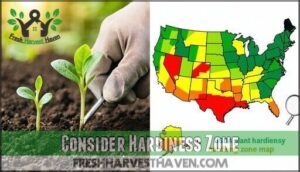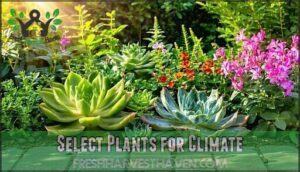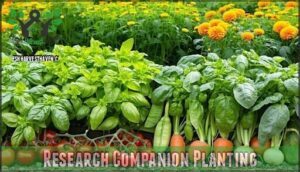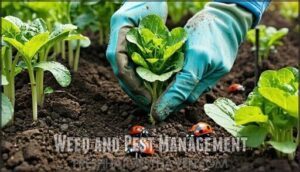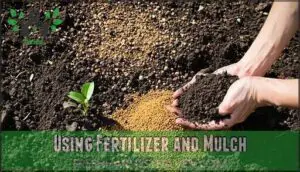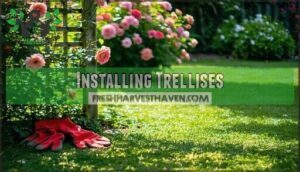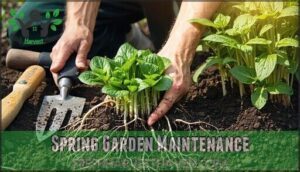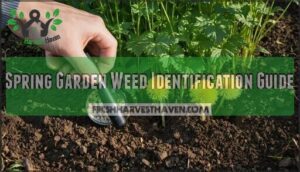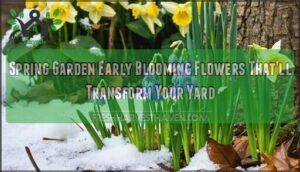This site is supported by our readers. We may earn a commission, at no cost to you, if you purchase through links.
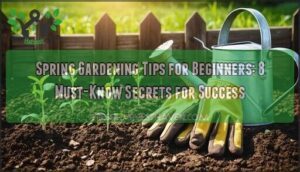 Starting your garden this spring doesn’t have to feel overwhelming. Begin by testing your soil’s pH and drainage, then choose easy-to-grow plants like lettuce, radishes, and marigolds that forgive beginner mistakes.
Starting your garden this spring doesn’t have to feel overwhelming. Begin by testing your soil’s pH and drainage, then choose easy-to-grow plants like lettuce, radishes, and marigolds that forgive beginner mistakes.
Wait until after your last frost date before planting tender vegetables outdoors. Prepare your beds by removing weeds and adding compost to improve soil structure.
Start small with a manageable plot size, and focus on consistent watering rather than drowning your plants with good intentions. These fundamental spring gardening tips for beginners will set you up for success. However, timing your plantings correctly can make or break your entire season’s harvest.
Table Of Contents
- Key Takeaways
- Spring Garden Preparation
- Top 8 Spring Gardening Essentials
- Choosing Right Plants
- Garden Preparation Tips
- Spring Garden Maintenance
- Frequently Asked Questions (FAQs)
- When should I start preparing my garden for spring?
- What is the gardening 3 year rule?
- What is the rule of 3 in gardening?
- What is the easiest plant to grow in spring?
- What is the most common mistake of first time gardeners?
- When should I start planting my spring garden?
- How should I prep my garden for spring?
- What is Spring Garden Planning?
- How do you plan a Spring Garden?
- Should you plant a garden in spring?
- Conclusion
Key Takeaways
- Start with soil preparation before planting – Test your soil’s pH and drainage, then add compost to improve structure. Wait until the soil reaches 45°F and isn’t soggy before you plant anything.
- Choose beginner-friendly plants that forgive mistakes – Start with easy crops like lettuce, radishes, and marigolds. Select plants suited to your hardiness zone and local climate conditions.
- Time your plantings correctly to avoid frost damage – Plant cold-hardy crops like peas and spinach first, then wait until after your last frost date before adding tender vegetables outdoors.
- Focus on consistent watering rather than overwatering – Check soil moisture by sticking your finger two inches deep before watering. Most beginners kill plants by watering too frequently instead of deeply.
Spring Garden Preparation
Getting your garden ready for spring means completing essential tasks before you start planting, including pruning trees and shrubs, checking your tools, and organizing your seeds and supplies.
Proper preparation guarantees your garden will thrive throughout the growing season, saving you time and preventing common mistakes that can hurt your plants later.
Prune Trees and Shrubs
Mastery in spring garden care starts with strategic pruning that transforms your landscape. You’ll reveal your garden’s potential by learning proper Pruning Techniques and Pruning Timing.
Shrub Shaping and Fruit Tree Pruning require different approaches, but both follow core principles:
- Remove dead, diseased, or pruning broken branches first
- Cut rose canes back to healthy wood using clean tools
- Prune before buds break for maximum healing
- Make cuts just above outward-facing buds
- Limit removal to 25% of the plant’s total growth
This pruning guide guarantees your shrubs develop strong structure. Before beginning, confirm you have the right cutting tools.
Rose Pruning demands extra attention—remove weak growth and open the center for airflow.
Check Tools and Equipment
After finishing your pruning work, you’ll want to give your garden tools the attention they deserve. Think of it as a tune-up for your gardening equipment—clean tools work better and last longer.
Start with Equipment Cleaning using warm soapy water and a wire brush for stubborn dirt. Check each tool for damage and Repair Broken handles or bent tines before they become bigger problems.
Tool Sharpening is next—dull blades tear plants instead of cutting cleanly, which can invite disease. Proper cleaning helps to prevent rust damage.
Don’t forget Glove Inspection either. Torn gloves let thorns through, and nobody wants that surprise.
Proper tool maintenance now saves you money and frustration later. It’s a crucial step in ensuring your gardening equipment remains in good condition, making your gardening tasks more efficient and enjoyable.
Inventory Seeds and Supplies
Smart gardeners know that spring gardening success starts with organized supplies.
Smart gardeners know that spring success starts with organized preparation.
Before placing your seed ordering, take inventory of what you already have. Check seed viability by reviewing expiration dates—seeds older than two years often fail to germinate. You can also purchase seed testing supplies online.
Here’s your supply organization checklist:
- Sort seeds by planting dates and crop types
- Test tool maintenance needs before busy season arrives
- Create wishlists for missing beginner gardening essentials
- Set budgeting supplies limits to avoid overspending
Plan Your Garden
Your garden planning starts with smart space assessment. Sketch your garden layout considering sunlight needs and plant heights.
Create a planting schedule that groups crops by harvest time and growth habits. Focus on seed selection that matches your climate zone and experience level.
These beginner tips for choosing plants prevent overcrowding disasters. Planting seeds succeeds when you match varieties to available space.
Proper beginner gardening requires thoughtful planning before you dig.
Top 8 Spring Gardening Essentials
You’ll need specific tools and supplies to transform your garden from winter-weary to spring-ready, and having the right essentials makes the difference between struggling through tasks and enjoying smooth, successful results.
These eight carefully selected items will equip you with everything necessary to tackle soil preparation, planting, watering, and ongoing maintenance with confidence throughout the growing season.
1. Complete Guide to Gardening Success
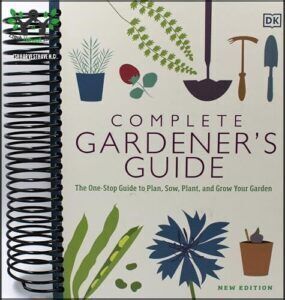
The Complete Gardener’s Guide serves as your gardening mentor, transforming overwhelming tasks into manageable steps. This thorough resource helps you avoid common beginner mistakes while building confidence in your spring gardening journey.
Packed with vibrant photos and troubleshooting solutions, it covers everything from soil preparation to plant selection. You’ll discover proven techniques for garden planning and seasonal tasks that actually work.
- Step-by-step instructions for planting seeds and nurturing growth
- Visual guides showing proper soil preparation techniques
- Pest control strategies that protect your plants naturally
- Seasonal task calendars keeping you organized year-round
Best For: Gardening beginners seeking reliable guidance and experienced gardeners wanting extensive reference material.
2. Digital Soil Moisture Test Meter
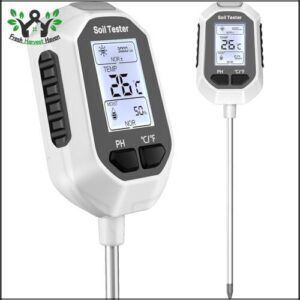
After mapping out your garden success plan, you’ll need reliable soil testing tools to make smart watering decisions.
A digital soil moisture test meter transforms your soil preparation approach by delivering precise meter accuracy across different soil types.
This device eliminates guesswork, showing you when plants need water and when they don’t.
Reading consistency helps you maintain optimal moisture levels, preventing both drought stress and root rot.
Most meters work in various soil conditions, from sandy to clay-heavy ground.
For meter maintenance, simply wipe the probe clean after each use and store it properly.
Regular soil testing with this tool helps you understand your garden’s unique needs, making soil amendments more effective.
You’ll water with confidence, knowing your plants get exactly what they need when they need it.
3. Herb Seeds Variety Pack Garden
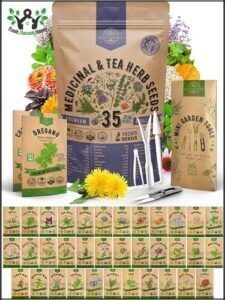
After mastering soil moisture, you’ll want to explore Herb Seed Selection that transforms your space into a culinary paradise. A herb seeds variety pack offers 35 non-GMO options perfect for Indoor Herb Growing and beginners looking to expand their gardening tips arsenal.
These packets work like a chef’s spice collection, delivering fresh basil, mint, and lavender right to your kitchen. With high germination rates and resealable packaging, they adapt to various soil conditions while supporting Companion Herb Planting strategies.
Three key benefits of herb gardening variety packs:
- Culinary Herb Uses – Fresh ingredients for cooking and teas
- Herb Garden Design flexibility – Mix colors, textures, and scents
- Gardening seeds convenience – Multiple varieties in one purchase
Best For: All experience levels seeking diverse, fresh herbs for indoor or outdoor cultivation.
4. indoor kitchen herb garden starter
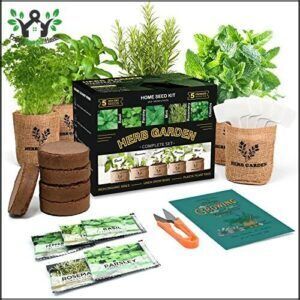
Fresh herbs transform your cooking from ordinary to extraordinary, and an indoor kitchen herb garden starter makes this dream achievable for beginners.
These thorough kits include everything you need: seeds, soil disks, containers, and detailed instructions for herb selection like basil, parsley, and mint.
Container choice matters—ensure proper drainage holes for healthy root development.
Lighting needs vary by herb, but most thrive near south-facing windows with 4-6 hours of direct sunlight.
Watering tips include checking soil moisture daily and avoiding overwatering, which causes root rot. Indoor seed starting gives you year-round access to fresh flavors.
Basic pest control involves inspecting leaves weekly for aphids or spider mites.
Best For: Beginner gardeners seeking fresh herb gardening success indoors.
5. Galvanized metal raised garden beds
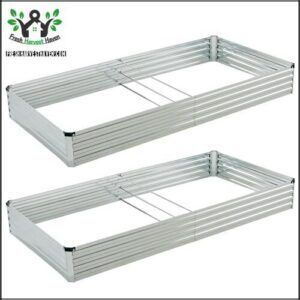
While herb gardens give you fresh flavors indoors, galvanized metal raised beds transform your outdoor growing game completely.
These steel powerhouses offer unmatched Metal Bed Durability compared to wooden alternatives that rot and splinter.
Galvanized Steel Safety means no harmful chemicals leaching into your soil, making them perfect for vegetable gardening.
Bed Size Selection matters—12-inch depth works great for most crops, herbs, and flowers.
The open bottom design guarantees excellent Soil Compatibility and drainage, preventing waterlogged roots that kill plants.
For spring maintenance and garden preparation, these raised beds require zero upkeep.
They resist rust, weather, and pests while maintaining clean lines that enhance your yard’s Aesthetic Considerations.
For superior soil health, consider mixing topsoil with compost and adding organic matter.
Assembly takes minutes, not hours, letting you focus on planting instead of construction.
Your back will thank you for the elevated growing height too.
Best For: Gardeners wanting durable, low-maintenance raised beds for vegetables and herbs.
6. Heavy Duty Garden Soaker Hose
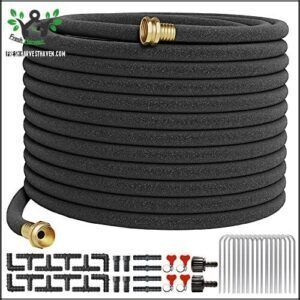
When you’re tackling spring watering tasks, a heavy-duty garden soaker hose becomes your secret weapon for efficient irrigation.
These specialized gardening tools deliver water directly to plant roots, conserving up to 70% more water than traditional garden hoses.
Quality hose material with solid brass connectors guarantees leak prevention and long-lasting performance.
Here are essential gardening tips for beginners using soaker hoses:
- Place hoses 12-18 inches from plant stems for ideal placement
- Maintain water pressure below 60 psi for pressure regulation
- Install above or below ground in vegetable gardens and flower beds
- Combine with timers for automated garden watering systems
Perfect for water conservation-minded gardeners seeking sustainable solutions.
7. Organic Orchid Potting Bark Mix
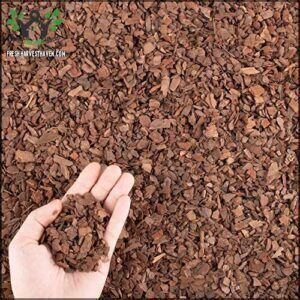
While a quality soaker hose keeps your garden hydrated, your orchids need something completely different to flourish. Organic orchid potting bark mix transforms struggling plants into stunning specimens through superior aeration and drainage.
This specialized medium prevents the root rot that kills most orchids. Made from sustainably sourced pine bark, it mimics orchids’ natural growing conditions while providing gentle nutrition. Whether you’re repotting orchids for the first time or switching from regular potting soil, this organic gardening essential makes all the difference.
| Orchid Type | Bark Size | Mix Ratio |
|---|---|---|
| Phalaenopsis | Medium chunks | 70% bark, 30% moss |
| Cattleya | Large pieces | 80% bark, 20% perlite |
| Dendrobium | Small-medium | 60% bark, 40% moss |
| Oncidium | Medium | 75% bark, 25% perlite |
| Vanda | Extra large | 90% bark, 10% moss |
Store your bark mix properly to prevent mold. These gardening basics guarantee your beginner’s success with these exotic beauties.
8. Miracle Gro Shake N Feed All Purpose Plant Food
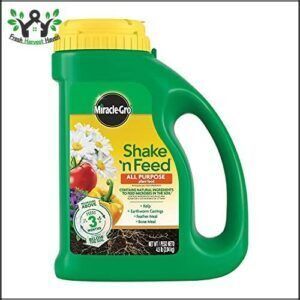
After selecting the right potting mix, you’ll want to feed your plants properly.
Miracle Gro Shake N Feed All Purpose Plant Food delivers continuous plant nutrition with its controlled nutrient release rate that feeds plants for up to three months.
This granular fertilizer simplifies plant care for gardening beginners by eliminating guesswork in fertilizing plants.
The application methods are straightforward: sprinkle evenly around plants, work lightly into soil, then water thoroughly.
While it supports robust plant growth across vegetables, flowers, and herbs, consider your plant-specific needs first.
Some gardeners prefer organic alternatives for edible crops due to environmental impact concerns.
Best For: New gardeners wanting reliable, long-lasting nutrition that strengthens roots and promotes vibrant blooms without frequent reapplication.
Choosing Right Plants
Selecting the right plants for your spring garden requires careful consideration of your hardiness zone, climate conditions, and specific growing requirements.
You’ll want to match each plant’s needs with your garden’s sun exposure, soil type, and local weather patterns to guarantee healthy growth and successful harvests.
Consider Hardiness Zone
USDA Hardiness Zones guide beginners toward planting success by matching Plant Hardiness with your location’s climate.
These gardening zones reveal which plants survive winter temperatures in your area. Microclimates Matter too—your backyard might differ from neighboring yards due to wind patterns or sun exposure.
Check Zone Planting Dates and frost dates before selecting varieties. Regional Variations affect Frost Tolerance, so research local conditions.
Understanding zones prevents costly mistakes during garden cleanup and replanting seasons.
Select Plants for Climate
Beyond knowing your hardiness zone, you’ll need plants that match your specific climate conditions.
Regional varieties perform better than generic options because they’re adapted to local weather patterns.
Consider these climate factors when planting:
- Sun exposure requirements for your garden’s light conditions
- Soil preferences including drainage and pH levels
- Water needs matching your area’s rainfall patterns
- Microclimate gardening opportunities in your yard
- Plant hardiness ratings from your local nursery.
Smart selection prevents costly mistakes.
Research Companion Planting
Once you’ve picked climate-appropriate plants, companion planting takes your garden to the next level.
Think of it as matchmaking for vegetables—beneficial pairings create natural pest control and nutrient synergy.
Plant basil near tomatoes for growth support, or scatter marigolds among your vegetable planting for bug deterrence.
Try the classic trio: corn supports beans while squash spreads below for space optimization.
Cool-season crops like peas, beets, carrots, and radishes work well together since they share similar growing conditions and won’t compete aggressively for resources.
Gardeners can also leverage the benefits of nitrogen fixing plants like beans and peas to improve soil fertility for future crops.
Plant Selection for Pollinators
Your garden becomes a pollinator paradise when you choose native species that bloom throughout spring and summer. Native pollinators depend on diverse flower shapes and bloom times for survival. Smart plant selection creates essential habitat creation while supporting beneficial insects.
Here’s your pollinator-friendly action plan:
- Plant native wildflowers – they’re perfectly adapted to local pollinator needs
- Stagger bloom times – guarantee continuous nectar from early spring blooms through fall
- Create plant diversity – different flower shapes attract various beneficial species
Skip pesticides completely. Consider adding native bee hotels to provide shelter.
Garden Preparation Tips
You’ll transform your garden space into a thriving ecosystem by focusing on four essential preparation steps that set the foundation for healthy plant growth.
These practical techniques address soil quality, pest control, nutrient management, and structural support to guarantee your plants get the best possible start this growing season, by utilizing complete concepts.
Weed and Pest Management
After selecting your plants, you’ll need effective weed control and pest management strategies.
Combat garden invaders with these proven methods:
- Pull weeds early before they spread seeds throughout your garden
- Apply organic mulch for natural weed prevention and moisture retention
- Attract beneficial insects like ladybugs for natural pest identification and control
Consistent weed removal beats reactive approaches every time.
Minimizing disruption helps prevent weed seed germination.
Checking Soil Quality
Once you’ve handled weeds, soil testing importance becomes your next priority.
Check soil pH levels and identify nutrient deficiencies through home test kits or professional analysis.
Address soil compaction fixes by loosening hardpacked areas.
Monitor soil temperature for ideal seed germination—45°F minimum for cool crops.
Follow soil testing guidelines and apply proper amendments like compost.
Fix compacted soil now for thriving plants later.
Using Fertilizer and Mulch
After checking your soil quality, it’s time to feed your garden properly.
Smart fertilizer and mulch application transforms ordinary dirt into plant paradise.
Fertilizer Types work best when matched to your Nutrient Needs:
- Balanced fertilizers (6-6-6 or 8-8-8) provide equal nitrogen, phosphorus, and potassium for general garden use
- Organic Options like compost and slow-release plant food improve Soil Enrichment naturally
- Mulch Application at 2-3 inches deep retains moisture while suppressing weeds effectively.
Consider balanced fertilizer options for ideal growth.
Installing Trellises
Choosing the right trellis materials sets your climbing plants up for success. You’ll find sturdy options like cedar, metal, or vinyl at garden centers, each offering different benefits for your garden design.
Install your trellis before planting to avoid disturbing roots later—this simple step saves countless garden chores down the road.
Proper trellis placement near walls or fences maximizes plant support while complementing your space. Remember, regular pruning keeps climbers healthy and your trellis looking its best throughout garden maintenance seasons.
Spring Garden Maintenance
Once your garden is prepared and planted, you’ll need to maintain it throughout the growing season to guarantee healthy, productive plants.
Regular maintenance tasks like pruning spent blooms, dividing crowded perennials, aerating compacted soil, and adjusting your watering schedule will keep your garden thriving from spring through summer.
This includes tasks such as dividing crowded perennials, aerating compacted soil, which are crucial for maintaining a healthy garden.
Pruning and Deadheading
Sharp pruning techniques transform your garden from messy to magnificent. Deadheading flowers keeps blooms coming while shrub shaping creates structure.
Transform your garden from chaos to beauty with sharp, purposeful cuts that speak directly to your plants.
Here’s your spring maintenance roadmap:
- Clean cuts above buds – Use sanitized tools for precise pruning plants
- Remove dead rose canes – Cut damaged wood to healthy tissue
- Snip spent blooms – Deadheading redirects energy to new growth
- Tool maintenance matters – Sharp, clean equipment prevents disease spread
Regular pruning and deadheading aren’t chores—they’re conversations with your plants.
Gardeners should also consider spring garden preparation for best results.
Dividing Overgrown Perennials
After you’ve finished your pruning tasks, overgrown perennials need your attention for healthy spring gardening. Division Timing matters most when shoots first emerge but haven’t fully developed. Split these crowded plants to restore their vigor and blooming potential.
Here’s your step-by-step approach for dividing perennials:
- Choose sharp spades or garden forks for clean Tool Selection
- Dig around the entire root ball carefully
- Examine Root Health and remove any dead sections
- Split clumps into smaller portions with healthy roots
- Plant divisions at proper Replanting Depth matching original soil level
Proper Post-Division Care includes thorough watering and mulching for successful plant division results.
Raking and Aeration
Proper raking removes leaves, debris, and sticks while preparing your garden beds for spring growth.
Use raking techniques that won’t damage emerging plants—work gently around bulbs and perennials.
Soil aeration follows naturally after cleanup, creating pathways for water and nutrients. Thatch removal prevents disease buildup.
Quality aeration tools make the job easier. Follow with compost topdressing for superior results.
Watering and Irrigation
Once you’ve finished raking, smart watering becomes your garden’s lifeline. You’ll want to master watering techniques that keep plants happy without drowning them.
Here’s your watering game plan:
- Check soil moisture before watering – stick your finger two inches deep
- Set up irrigation systems like drip lines for consistent moisture retention
- Create a watering schedule based on your region’s needs
Water conservation starts with timing and technique.
Frequently Asked Questions (FAQs)
When should I start preparing my garden for spring?
Like awakening from winter’s slumber, your garden preparation should begin in late winter when soil isn’t frozen solid.
Start cleaning up debris and planning around six weeks before your area’s last expected frost date.
What is the gardening 3 year rule?
The gardening 3-year rule suggests you’ll sleep the first year, creep the second, and leap the third.
New perennials need time to establish roots before showing their full potential and vigor.
What is the rule of 3 in gardening?
Good things come in threes.
You’ll plant three of the same species together for visual impact, use three different heights for depth, and repeat groupings three times throughout your garden for cohesive design flow, which can be summarized as creating a design with complete concepts.
What is the easiest plant to grow in spring?
Radishes are your best bet for spring success.
They’re practically foolproof, sprouting in just days and ready to harvest within a month.
Plant them directly in cool soil and watch them thrive effortlessly.
What is the most common mistake of first time gardeners?
Nearly 70% of new gardeners overwater their plants, literally drowning them with kindness.
You’re probably watering too frequently instead of deeply.
Check soil moisture by sticking your finger two inches down before watering again, to avoid overwatering.
When should I start planting my spring garden?
Wait until your soil reaches 45°F and isn’t soggy before planting.
You can start cold-hardy crops like peas, lettuce, and spinach first, then add warm-season vegetables after your last frost date.
How should I prep my garden for spring?
Clean debris from beds, rake gently around emerging plants, and test your soil temperature.
Wait until it’s consistently 45°F before planting.
Add compost, repair any frost damage, and sharpen your tools.
What is Spring Garden Planning?
Spring garden planning means deciding what you’ll grow, where you’ll plant it, and when to start.
You’ll consider your space, sunlight, soil type, and which plants work best in your area, which is a complete concept to keep in mind.
How do you plan a Spring Garden?
You’ll want to assess your space, sunlight, and soil conditions first.
Then research plants suited for your zone and create a layout based on height requirements.
Should you plant a garden in spring?
Strike while the iron’s hot—absolutely plant your garden in spring.
You’ll get cool-season crops like lettuce and peas established early, plus warm soil preparation sets you up for summer vegetables later.
Conclusion
Transforming your outdoor space from barren ground into a thriving sanctuary becomes achievable when you apply these spring gardening tips for beginners consistently.
You’ve learned the essential preparation steps, plant selection strategies, and maintenance techniques that separate successful gardens from failed attempts.
Remember, gardening isn’t about perfection—it’s about patience and persistence.
Start with one or two techniques, build your confidence gradually, then expand your skills.
Your garden will reward your dedication with abundant harvests and beautiful blooms throughout the growing season.
- https://sharon.audubon.org/staff/sunny-kellner
- https://ucanr.edu/blog/over-fence-alameda-county/article/spring-last-those-weeds-tips-controlling-common-weeds
- https://www.finegardening.com/project-guides/gardening-basics/six-tips-for-effective-weed-control?srsltid=AfmBOopvldLihb5Rkc8ywVLV4N7vrUsia40zsy6yxkDvM_hms4R4rsPn
- https://www.dammannsgardenco.com/blog/beginners-guide-to-weed-control
- https://plantsomethingli.com/spring-gardening-easy-with-5-simple-tips/

